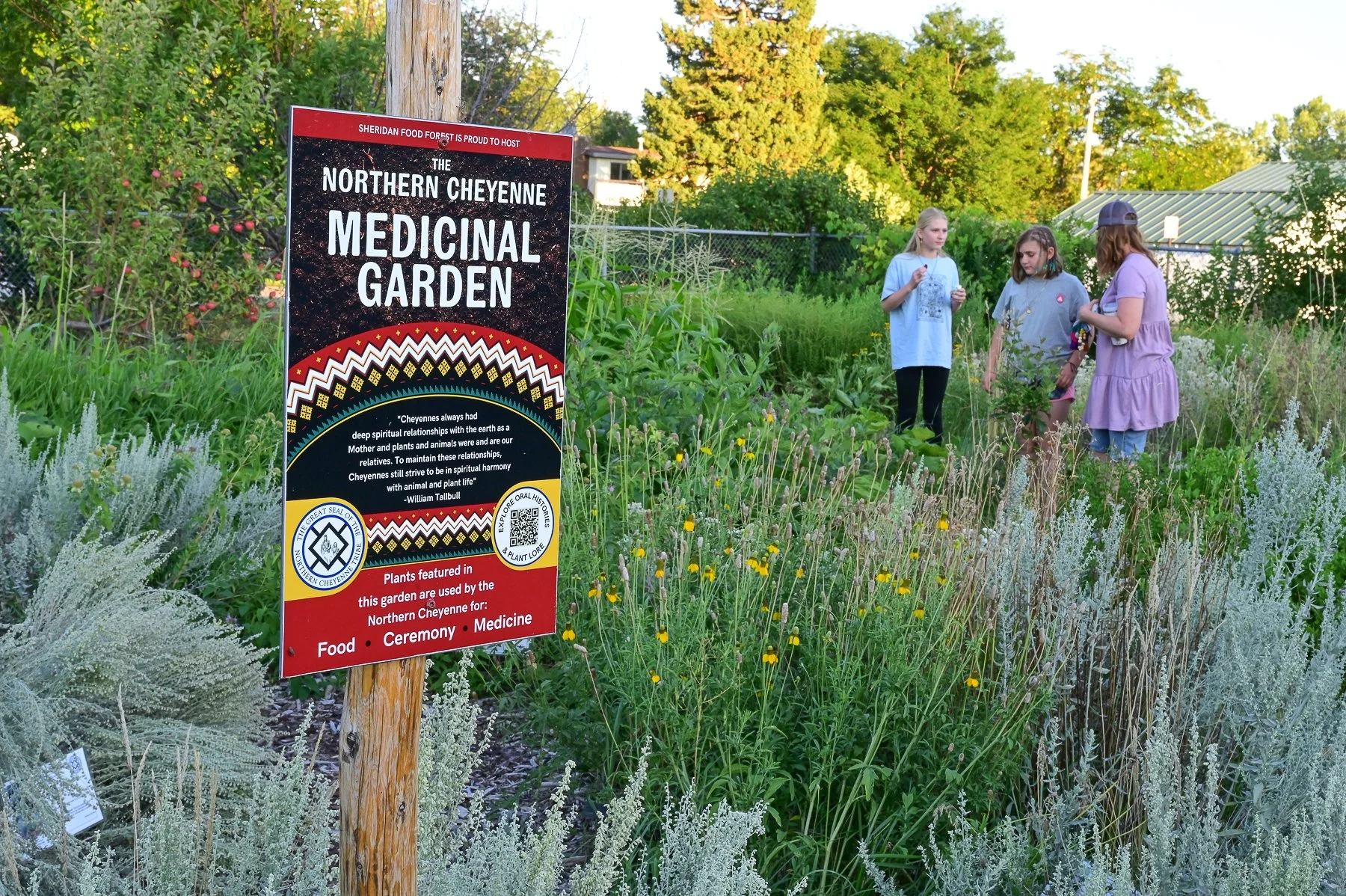The Magic of Plants: The Sheridan Food Forest hosts its second Northern Cheyenne Native Plant Traditional Uses & Plant Lore event
The Sheridan Food Forest recently hosted its second Northern Cheyenne Native Plant Traditional Uses & Plant Lore event, featuring Northern Cheyenne elder and ethnobotanist Linwood Tall Bull and his son, Randall Tall Bull. This event celebrated the multifaceted power of community green spaces, fostering connections through Indigenous knowledge, storytelling, and the shared appreciation of the land and its gifts. Originally established to create a more connected and food-secure community, the Sheridan Food Forest has evolved into a vibrant space for education and cultural exchange, where traditions and stories come alive.
As the Wyoming evening sun bathed the Food Forest in warm light, the event unfolded amidst western yarrow, glowing chokecherries, and wild asparagus. Families and community members gathered along pathways lined with medicinal herbs and fruit trees, while children harvested food under their parents' guidance. Others explored displays of Indigenous tools crafted from buffalo parts, each item holding its own story of practicality and cultural significance.
Linwood and Randall Tall Bull shared the stage, alternating between stories and teachings about the traditional uses of plants and animals. Linwood’s deep knowledge as an ethnobotanist and culture preservationist provided rich context to the evening’s lessons, while Randall’s craftsmanship and practical knowledge of traditional tools and plant medicines added layers of meaning. Together, they emphasized not just the medicinal and utilitarian aspects of these plants but also the broader lessons they impart about sustainability and intergenerational responsibility.
Linwood highlighted the importance of fostering sapling growth for harvests that the grower might never live to see. “This work is for generations to come,” he said, underscoring the need to cultivate not only plants but a more connected and just future. While Randall’s reflections deepened this theme, “Everything has a story. All of these have lengthy stories. Every part of a buffalo has a lengthy, lengthy story, and this is how children learn.”
The audience was invited to engage directly with the traditions, grinding chokecherries to form patties and tasting teas and herbal beverages crafted from plants like elk mint, echinacea, and sweet flag. These hands-on activities created tangible connections to the knowledge being shared. Throughout the evening, Linwood’s words offered a profound perspective on humanity’s relationship with the natural world.
“If you feel loneliness, all you have to do is go and touch them or place your hand on the tree, your hand will start shaking. It’ll go up your arm. It’ll take away your sadness. This is the magic of plants.”
The event highlighted plants such as man sage, black root mocha, pearly everlasting, rattlesnake rush, milkweed, rose bush, juneberry leaves, chokecherries, elk mint, and squash. Each plant’s significance was explored, from their medicinal properties to their roles in the stories and traditions of the Northern Cheyenne people. For example, echinacea, known as “yellow coneflower” or “rattlesnake medicine,” carries healing properties deeply tied to Northern Cheyenne cultural heritage.
Randall emphasized the importance of using every part of the buffalo, illustrating its integration into traditional practices and teachings. Randall’s demonstrations included the use of buffalo bladders as water containers and crafting tools from natural materials. His examples illustrated cultural ingenuity and sustainability. Both speakers underscored the value of preserving traditional practices as a means of strengthening community bonds and ensuring cultural continuity.
The Northern Cheyenne Garden, a new addition to the Sheridan Food Forest, serves as an ethnobotanical bridge, fostering understanding and connection between cultures. Piney Island Native Plants contributed native flora, while the Food Forest’s volunteer community provided essential care and event support. The event was made possible by partnerships with the Powder River Basin Resource Council, the Sheridan Rotary Club, and Piney Island Native Plants.
As the evening concluded, participants left with more than just the taste of chokecherry patties or herbal teas. They carried with them the wisdom of generations and a renewed sense of stewardship for the land. Events like these underscore the vital role of shared green spaces in bridging cultural divides and planting the seeds for a more connected future. “This is the magic of plants,” Linwood reminded everyone. “They follow you home.”




